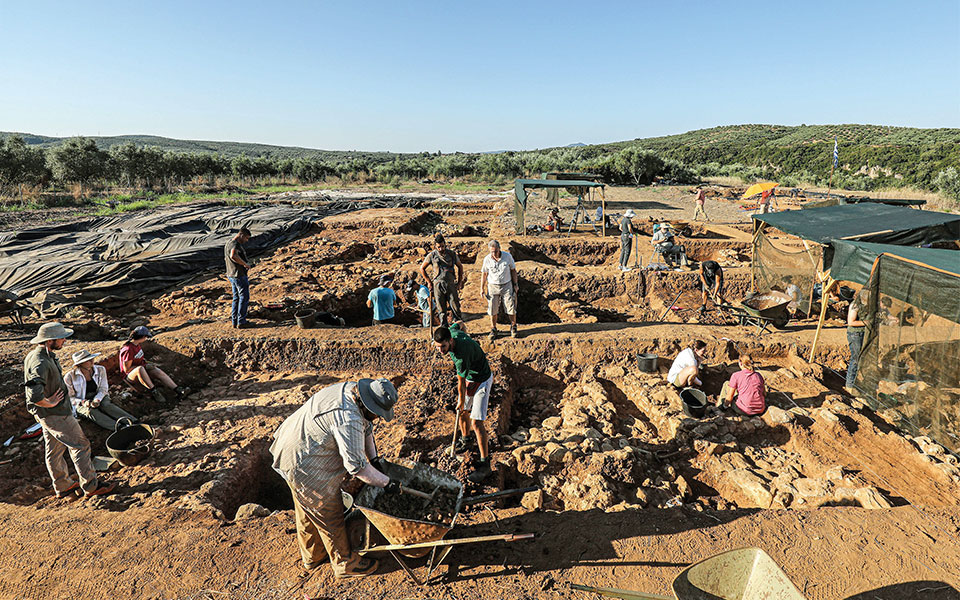Along with the remains of settlements, they excavate the lost line of ancient time and, little by little, they feel its chimerical flow; they trace the incessant, sometimes violent changes, but also time beyond time, the eternity of human nature, that inexhaustible force that creates and destroys worlds. With hoes, pickaxes, small pickaxes, shovels, trowels, scrapers, spatulas, brooms, brushes, rubber baskets, wheelbarrows, chisels, hammers, measuring tapes, twines, sponges, sprayers, calipers, spirit levels, dumpy levels, drones, calendars, tablets and laptops, they reverse the false perception of space formed by oblivion; they rebuild the irretrievable, handling the traces of history with meticulousness and gentility.
One day spent at an excavation site is like a dive into a long poem, an epic, an Iliad, an Odyssey, a Mahabharata, a Gilgamesh Epic and also the most edifying experiential lesson on accurately approaching the distant past. We found ourselves at the excavation of Iklaina, in Pylos, guided by its orchestrator and conductor, Michael Cosmopoulos, Professor of Archeology and holder of the Distinguished Chair of Greek Studies at the University of Missouri, in St. Louis.
The site is located on an enchanting plateau that overlooks the Ionian Sea, where it is believed that the first federal state of the western world developed between 1600 and 1100 BC. From dawn, as soon as the sun burst sweetly, mysteriously lengthening the shadows, until the high noon, Professor Cosmopoulos drew our gaze to the dimensions of the capital of a powerful Mycenaean state, the city of Iklaina, brought to light by the archaeologist’s trowel, with its cyclopean buildings, huge edifices and impressive architecture.
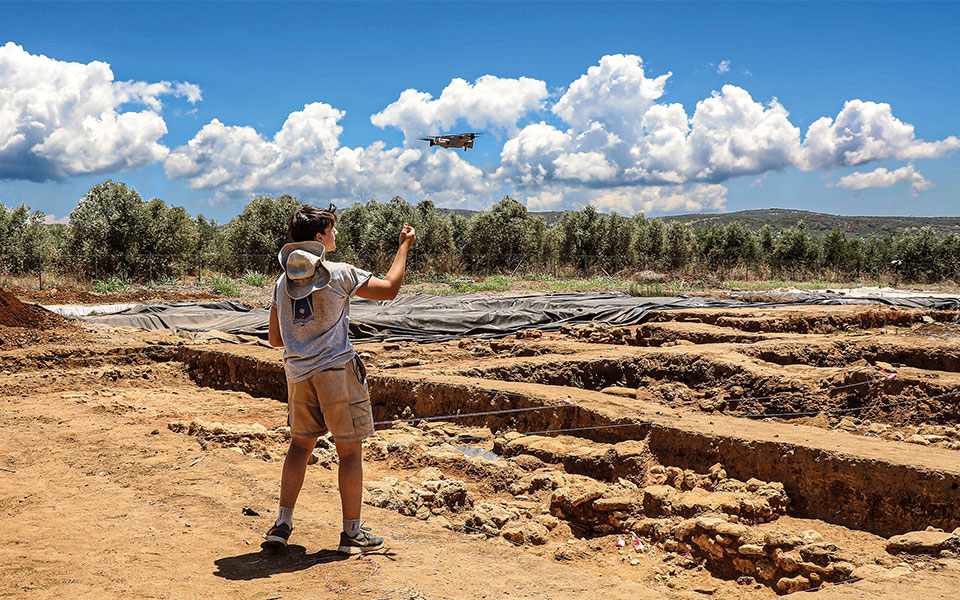
© Nikos Kokkalias
A WALK AROUND THE CITY
The bases of the two parts of the city, the brilliant administrative center and the houses – small mansions with central hearths – and the workshops, emerge from the red soil to the golden light. We pass by the large corner stones of the gate, heading to the administrative center, stepping on the wide, perfectly preserved paved road, which is now covered with special materials that protect it from temperature fluctuations. We stop before the remains of a monumental building, unique in Mycenaean architecture, as revealed by its pillars and dimension stones. We come across the remains of two other buildings.
“Buildings are almost on the surface, many of them have never been buried and for centuries the inhabitants of the area have been finding ready-made building material here; ancient stones are found in houses, wells and churches. So, in the archaeological site there are buildings that stop abruptly, there is one corner of a Mycenaean building here, another one there and the rest has disappeared forever,” explains Professor Cosmopoulos. We cross the paved square, from which a second paved road leads to the outdoor shrine. To the side, an almost intact stone-built sewer testifies to the advanced urban infrastructure – “the city had, from such an early date, a central drainage system with built-up sewers and a water supply network of earthen pipes.”
The entrance to the mud-built courtyard of the palace complex automatically makes us feel a lot smaller. In front of us stands a gigantic platform, made of boulders weighing four to six tons each, the so-called Cyclopean Terrace, which is four meters in height (the foundations continue for another two meters to the natural rock), 25m in length and eight meters in width. Now, 3,500 years later, sections of white plaster with traces of red and blue paint are preserved here and there. “This used to support a two or three-story building with impressive frescoes inside (more than 2,000 fragments of frescoes have been found here, depicting nautical scenes, hunting scenes, ladies of the court in procession, architectural features, and so on) and some auxiliary apartments on the side. Elements such as the monumental character and the unique architectural form of the complex, as well as the excellent quality frescoes, are compatible with its use as the ruler’s palace,” notes Professor Cosmopoulos.
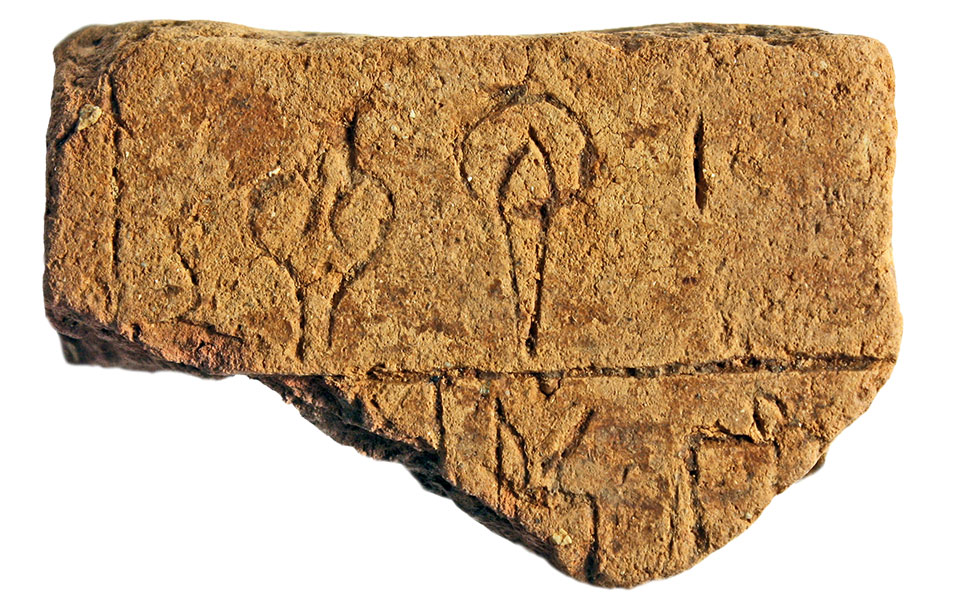


DIVIDED MESSINIA
Before us spreads the magnet of the Messinian land and sea. “In the middle of winter in America, I close my eyes and I see this landscape,” says the eminent professor. The surrounding hills, a calm harmony of lines, deep green and silvery green colors, lowering and sinking into the vast sea. “There was visual contact with Nestor’s Palace. For a big part of the Mycenaean period it appears that they were rivals, but they could see each other.”
Iklaina was an independent state, as confirmed by the discovery of the oldest Linear B tablet (1300 to 1350 BC), an excellent sample of Mycenaean bureaucracy, which is 100 to 150 years earlier than those found in the Palace of Nestor (1200 BC) “Our working hypothesis is that, for the biggest part of the Mycenaean period, Messinia was divided into independent states – one of them being Iklaina and another being Nestor’s Palace. Around 1250 BC, the ruler of Nestor’s Palace began occupying the neighboring states, thus creating the Mycenaean state of Pylos. Sixteen states (nine in the western part of the kingdom and seven in the east) turned into provinces of the kingdom – those are mentioned in the Linear B tablets found in Nestor’s Palace – retaining however part of their autonomy.
Given that each province had its own capital, government and administrative center but all came under the central authority of the Palace, this seems to be the first recorded instance of two levels of government in Western civilization. This is suggested by the evidence coming to light at Iklaina, the only Mycenaean capital to be systematically excavated. It seems that the new rulers of the area, by their violent occupation and the destruction of monumental buildings, obliterated all signs of the former political power and relegated Iklaina to a craft center.
Workshops and warehouses continued to be used for another 50 years and were abandoned with the destruction of the state of Pylos, around 1200 BC.”
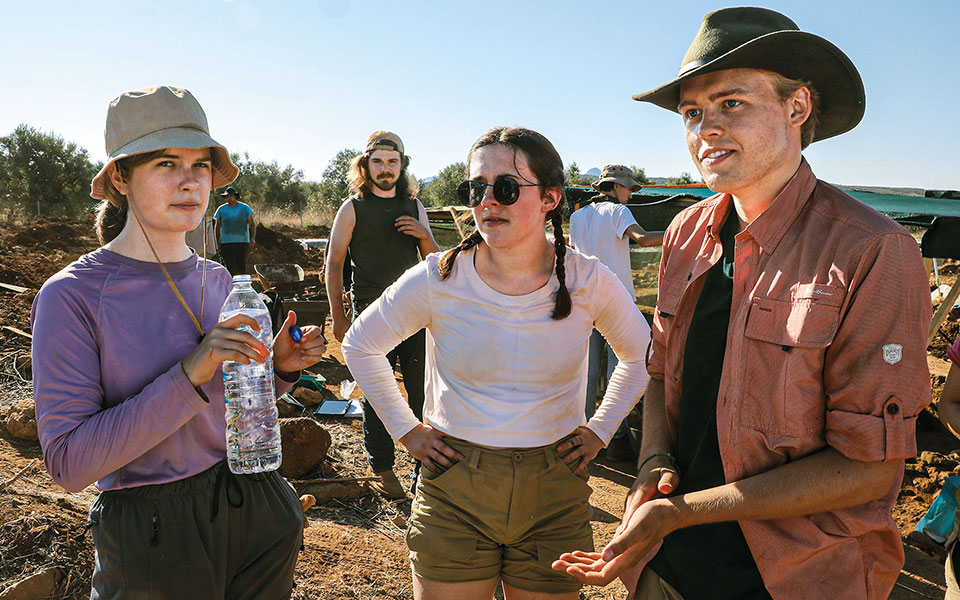
© Nikos Kokkalias
Iklaina was such a radiant Mycenaean center that its memory seems to have survived for at least four centuries after its abandonment, since it is mentioned by Homer in the Iliad. Experts believe it to be the same as Homer’s Aepy, one of Nestor’s nine cities in Rhapsody B of the Iliad, which are said to have sent ships to the Trojan War. “The memory of Nestor’s mighty palace and its states, nine in the western and seven in the eastern province, had survived until the time of Homer,” says Professor Cosmopoulos.
“I believe that the preservation of the memory of the great kingdom of Pylos among the local populations was made possible through social memory processes. Buildings that have never been buried function as places of memory and, combined with oral tradition, contribute to the preservation of historical memory,” he continues.
The city of ancient Iklaina, which is estimated to have had 5,000 to 6,000 inhabitants, occupies a large area. However, what has been revealed traces its origins, development, and violent destruction, along with the indestructible mechanisms of evolving human societies. Behind us lie stacked more than 130 cyclopean stones, which will be placed in their place during the restoration of the city.
“Once the restoration is completed with all the materials that have been found in the area, two routes are going to be created, one inside the fence, which will follow the course of the circulation of the ancient settlement and one elevated outside it, so that visitors can see the site even when it is closed. With a mobile application they will be able to target parts of the restored city and travel back in time.” The site was first explored by Spyros Marinatos during a four-day excavation in 1955 but was forgotten until the 1990s, when G. Korres included it in the list of Marinatos’ old important excavations.
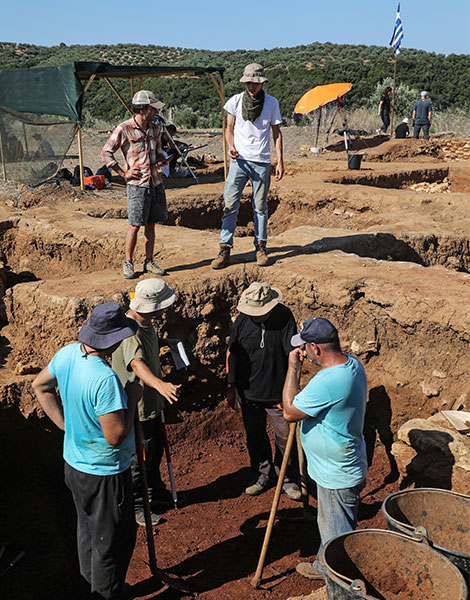
© Nikos Kokkalias
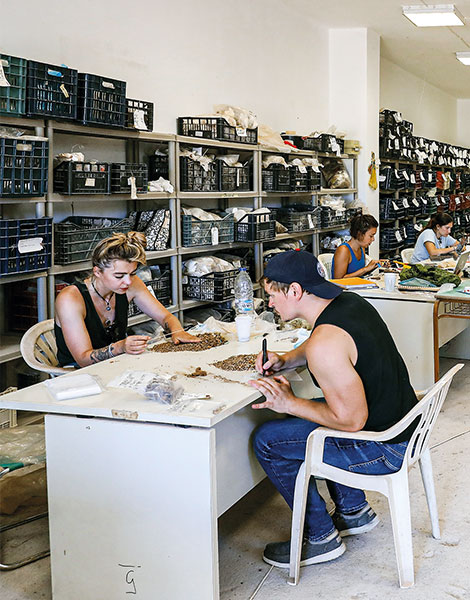
© Nikos Kokkalias
THE RESEARCH CHAIN
The team of dozens of archaeologists, specialist scientists, research assistants, students and local workers, working diligently before us, inside and outside the seven active excavation units in the area of the houses and workshops of the prehistoric city, reveals the length of time, the amount of effort, the depth of knowledge and the multi-level scientific synergy required to reconstruct this part of the past, with absolute precision.
On 1.5 hectares of land, a well-organized excavation is being developed, comprising all the links in the research chain. Before approaching the colorful beehive in the excavation units, we pass by the flotation machine, which is operated from a shadowy corner by the botanist Simos Ginoudis. Water in continuous flow rinses the soil that is systematically collected from the excavation units, “leaving seeds, botanical remains and charred organic matter to float on the surface. These finds are going to be collected and with their codes they are going to be sent for carbon dating and study under the microscope,” explains Mr Ginoudis. “But the remaining mixture of mud and small rocks is also collected and transported to the laboratory that operates in Pylos for the detection of small objects,” says Professor Cosmopoulos. “This way, we have found a tiny spearhead, small parts of loom frames et al. A professor used to tell me that excavations are like books. Every page you read, you tear it up and throw it away. You have to keep as much data as possible, otherwise they get lost.”
The sun is getting higher, but all of them, 45 out of the 60 participants in total who work on the project are methodically digging and troweling the soil (the remaining 15 are employed in the laboratory in Pylos, supervised by Professor Cosmopoulos’ wife, zooarchaeologist Dr Deborah Ruscillo).
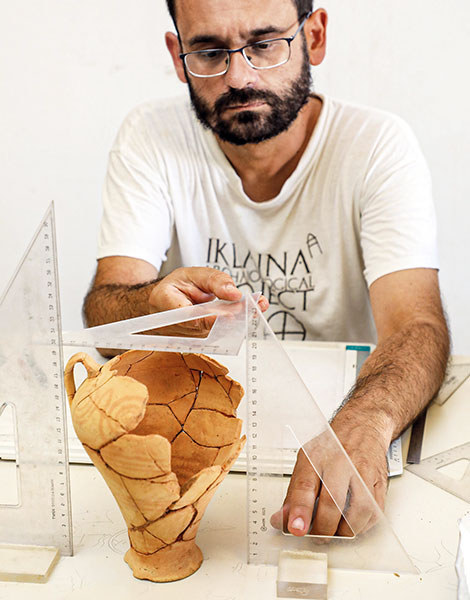
© Nikos Kokkalias
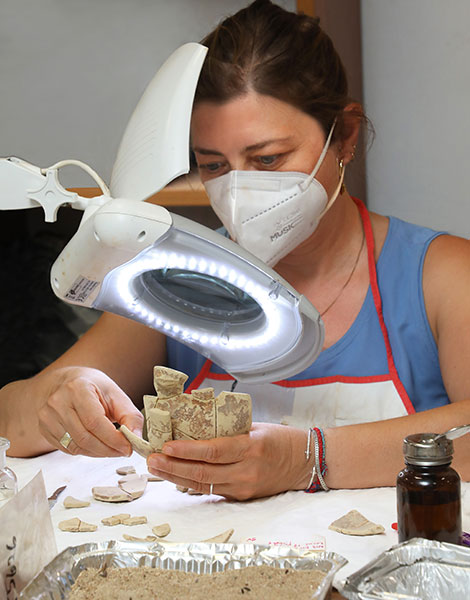
© Nikos Kokkalias
Students of the University of Missouri and other American and Canadian universities, Greek, Greek-American and American archaeologists and specialists are digging, measuring and recording. Graphic Designer Matt Stern, constructs the 3D map of the excavation using 3,000 photographs and operates geodetic stations that pinpoint the coordinates of the finds’ location with great precision.
Drones capture from the air each excavation unit separately and all the units together, so that all the scientific staff have immediate access to the information on the same day, as archaeologist Mary Tsoulakou from the Ephorate of Antiquities of Messinia says, who sacrificed her annual leave, just like the archaeologist Iro Valsamaki, in order to participate in the excavation. Archaeologists Stavroula Drakopoulou and Jennifer Globius are in charge of field surveillance. Archeology professor Dr Elizabeth Fisher and young Greek-American archaeologist Polina Makkou, like the other archaeologists in charge of the excavation units, no longer keep handwritten diaries but record everything on tablets and immediately enter all the data and findings into the database. The excavation architects are two: Steven Clark, who is studying the sections and Michael Nelson, who is conducting the general architectural study. The excavation foreman Giannis Kyriakopoulos has all the care of the site.
It’s getting close to 1.30 pm and work stops. Students will rest at the hotel or go swimming in Voidokilia or Finikounta – on Sundays they will visit archaeological sites. In the afternoon, they will attend the two-hour classes given daily by Professor Cosmopoulos – who has been repeatedly awarded for his excellent teaching, both in Canada and in the USA – and other experts. The distinguished archaeologist, member of four Academies, founder of two great centers of Greek culture, in Manitoba, Canada and Missouri, USA and organizer of study programs in Greece for foreign students, has a passion for Greece and young people. He introduces each student individually to the magic of Greek things. “And so they bond with the place, fall in love with it and when they leave, they confess that they feel homesick, choosing a word that people use for their homeland. They are the Philhellenes of tomorrow.”
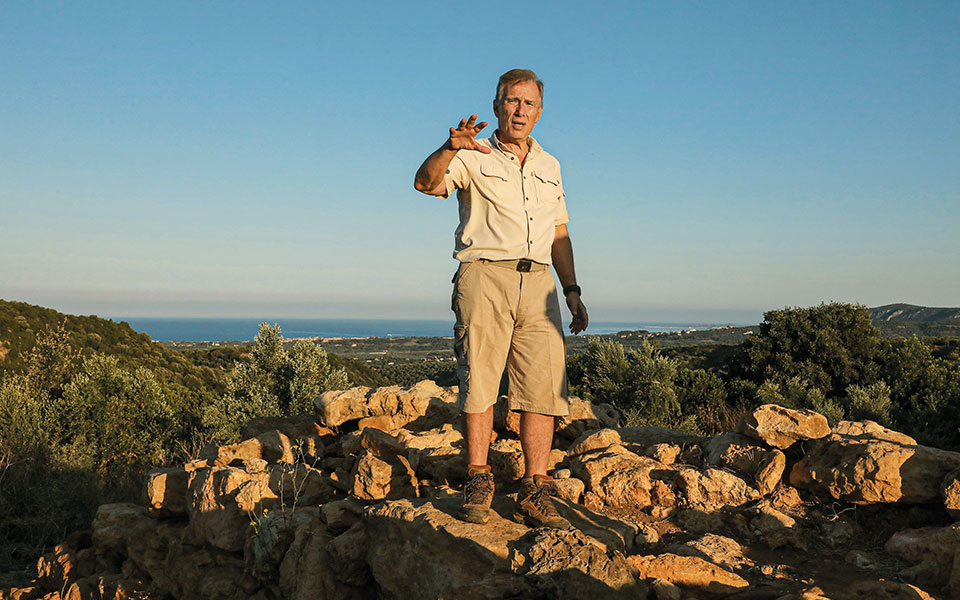
© Nikos Kokkalias
IN THE WAREHOUSE-LABORATORY
We arrive at the very well organized warehouse-laboratory, housed in a space granted by the Municipality of Pylos-Nestor, in Pylos, along with the collected samples and findings, where Dr Deborah Rouscillo introduces us to the scientific staff. Letty Chardon cleans and catalogs everything that goes into the warehouse. Students sort the ceramic sherds into categories by type, color, clay type and thickness and they try to find connections. “The amount of collected materials is huge, we collect half a ton of pottery every year,” says Ms Rouscillo. Ceramicist Joan Gulizio identifies the sherds and dates them, gives them a code and enters them with their description into the database. She packs them into groups with labels and files them. Maria Liston studies the human remains.
Conservator Stefania Veldemiri cleans the matching pieces and glues them together, reconstructing part or all of the object. She works with gentle, careful movements. A fragment from a fresco depicting a boat that she once conserved was printed on a postal stamp, when Greece held the presidency of the EU. Yannis Nakas, with a PhD in Maritime Archeology and an expert in Archaeological Drawing, traces with a pencil on a sheet of paper the restored side and the section of important finds. The designs will then be digitized and entered with their code into the database. “This helps ceramologists a lot with typology and dating,” he says. At the same time, he introduces students to Archaeological Drawing. George Vdokakis photographs the findings after being conserved and drawn, capturing the details and colors with absolute precision. Alexandra Katevaini organizes the database. Ceramist Pat Thomson checks that all recorded data is correct.
“We are a very close team. And our strong love for work extends to the other areas of our lives,” says Ms Veldemiri. “The excavation site and the laboratory work around the clock. We are happy to work here,” says Dr Nakas.
Michael Cosmopoulos, versatile, dynamic, innovative, quick and friendly, directs the multi-level research project with touching gentleness and kindness. He unobtrusively makes sure that not only everyone is working to the best of their ability but also that they’re having a good time; satisfied manual workers of another day of creation.

